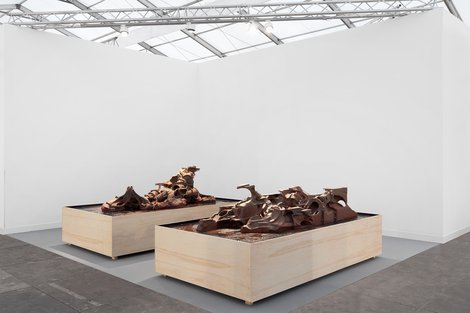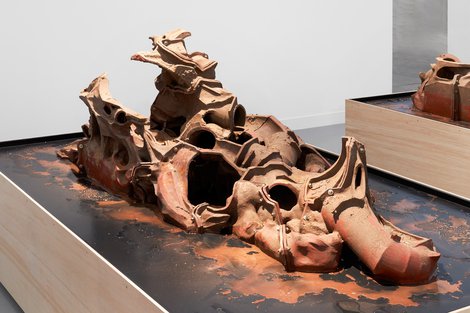Frieze London 2023
Laurence Sturla
Laurence Sturla
For Frieze Focus 2023, GIANNI MANHATTAN is pleased to present a new installation by Laurence Sturla (*1992 in Swindon, UK; lives and works in Vienna, AT).
In the middle of the booth, two large scale salt encrusted ceramics sit atop PVC covered plinths. The sculptures are fragmented sections of highly fired ceramics which are interlocked and bolt fastened. This reconstruction alludes to the impression of Sturla’s works as an excavated mechanical object, reconfigured in an attempt to understand its function or imagine how society made use of it as a whole.
In the middle of the booth, two large scale salt encrusted ceramics sit atop PVC covered plinths. The sculptures are fragmented sections of highly fired ceramics which are interlocked and bolt fastened. This reconstruction alludes to the impression of Sturla’s works as an excavated mechanical object, reconfigured in an attempt to understand its function or imagine how society made use of it as a whole.

11.12.23—11.12.23
GIANNI MANHATTAN, Wassergasse 14, 1030 Vienna
> Installation views
For Frieze Focus 2023, GIANNI MANHATTAN is pleased to present a new installation by Laurence Sturla (*1992 in Swindon, UK; lives and works in Vienna, AT).
In the middle of the booth, two large scale salt encrusted ceramics sit atop PVC covered plinths. The sculptures are fragmented sections of highly fired ceramics which are interlocked and bolt fastened. This reconstruction alludes to the impression of Sturla’s works as an excavated mechanical object, reconfigured in an attempt to understand its function or imagine how society made use of it as a whole.
In the middle of the booth, two large scale salt encrusted ceramics sit atop PVC covered plinths. The sculptures are fragmented sections of highly fired ceramics which are interlocked and bolt fastened. This reconstruction alludes to the impression of Sturla’s works as an excavated mechanical object, reconfigured in an attempt to understand its function or imagine how society made use of it as a whole.

These new works ground themselves in Anne Carson’s translation of If Not, Winter.
Focusing on the largely lost-poetry of Sappho and her remaining fragmented texts, Carson provides a space for these lost lines of poetry to be imagined, their loss just as present as the translation we are faced with. For Sturla this text embodies how history is reconfigured and marked the beginning of his enquiry into how absence can be utilised within his sculptural representations.
Sturla’s severed and salt encrusted ceramic structures offer a similar space of imagined and lost language. Their fragmented remains offer a coded version of a landscape, disjointed and separated in space. Sturla’s disjointed ceramic engines illustrate the fallacy between technological precision and our (in)ability to recall and visually digest space, function or logic.
Focusing on the largely lost-poetry of Sappho and her remaining fragmented texts, Carson provides a space for these lost lines of poetry to be imagined, their loss just as present as the translation we are faced with. For Sturla this text embodies how history is reconfigured and marked the beginning of his enquiry into how absence can be utilised within his sculptural representations.
Sturla’s severed and salt encrusted ceramic structures offer a similar space of imagined and lost language. Their fragmented remains offer a coded version of a landscape, disjointed and separated in space. Sturla’s disjointed ceramic engines illustrate the fallacy between technological precision and our (in)ability to recall and visually digest space, function or logic.
